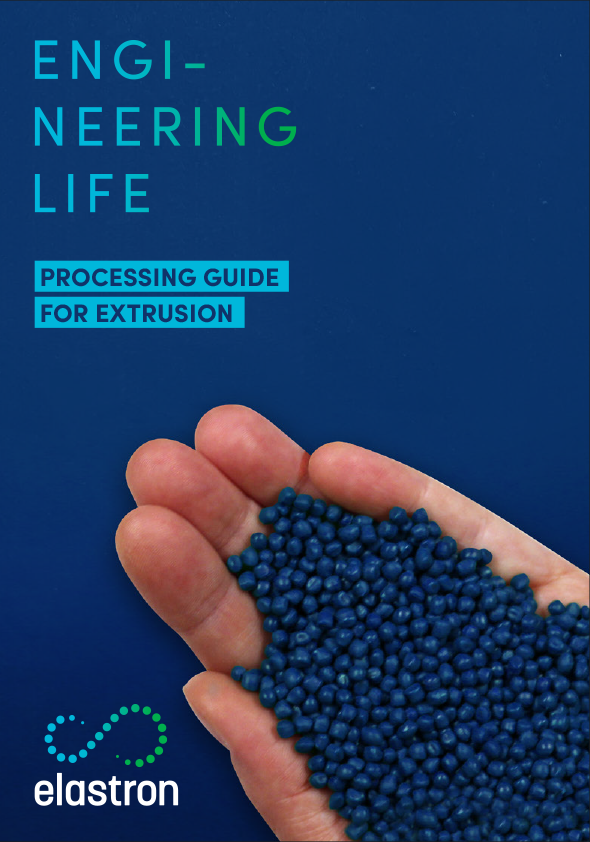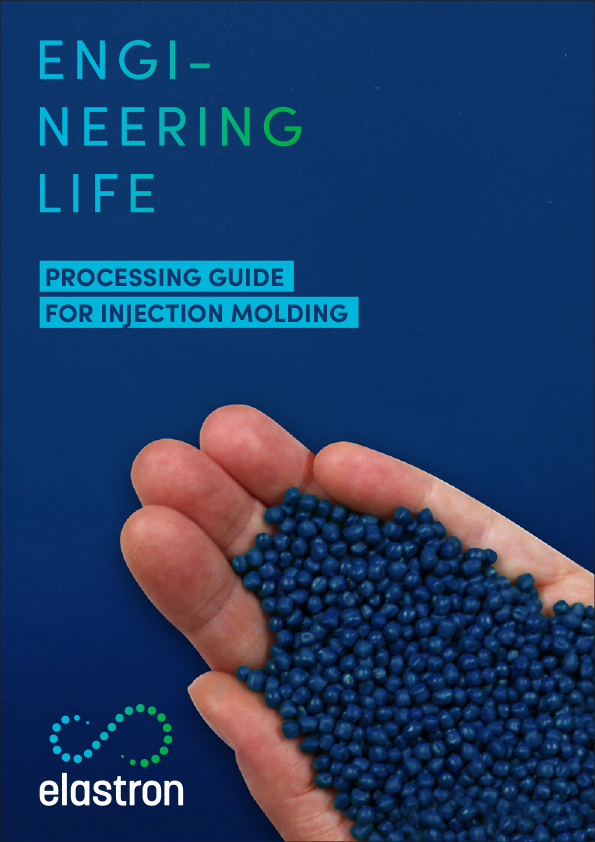Processing Guides
Processing Temperature Range for ELASTRON V
|
|
SHORE A 0-50 |
SHORE A 50-90 |
SHORE D 35-65 |
|
INJECTION |
150 - 180° C |
160 – 190° C |
180 – 220° C |
|
EXTRUSION |
160 – 190° C |
170 – 200° C |
180 – 220° C |
* In injection moulding with cored moulds, temperature should be mostly between 40 - 60° C, injection moulding with standard moulds, temperature should be between 20 - 40° C.
* In extrusion process, mould temperature should be 5-10° C higher than nozzle temperature.
* Drying is required before processing.
* According to the design of screws used in machines, temperatures can vary +/- 10° C.
Processing Temperature Range for ELASTRON G
|
|
SHORE A 0-50 |
SHORE A 50-90 |
SHORE D 35-65 |
|
INJECTION |
150 - 180° C |
160 – 190° C |
180 – 220° C |
|
EXTRUSION |
160 – 190° C |
170 – 200° C |
180 – 220° C |
* In injection moulding with cored moulds, temperature should be mostly between 40 - 60° C, injection moulding with standard moulds, temperature should be between 20 - 40° C.
* In extrusion process, mould temperature should be 5-10° C higher than nozzle temperature.
* Drying is recommended for some grades and in some conditions before processing.
* According to the design of screws used in machines, temperatures can vary +/- 10° C.
Processing Temperature Range for ELASTRON D
|
|
SHORE A 0-50 |
SHORE A 50-90 |
SHORE D 35-65 |
|
INJECTION |
120 - 160° C |
140 – 180° C |
170 – 200° C |
|
EXTRUSION |
130 - 170° |
150 - 190° |
170 - 210° |
* In injection moulding with cored moulds, temperature should be mostly between 10° - 30° C, injection moulding with standard moulds temperature should be between 10° - 20° C.
* In extrusion process, mould temperature should be 5-10° C higher than nozzle temperature.
* Drying is not required before processing.
* According to the design of screws used in machines, temperatures can vary +/- 10° C.
Processing Temperature Range for ELASTRON TPO
|
|
SHORE A 0-50 |
SHORE A 50-90 |
SHORE D 35-65 |
|
INJECTION |
150 – 190° C |
170 – 200° C |
180 – 220° C |
|
EXTRUSION |
160 – 200° C |
180 – 210° C |
190 – 230° C |
* In injection moulding with cored moulds, temperature should be mostly between 10° - 30° C, injection moulding with standard moulds temperature should be between 10° - 20° C.
* In extrusion process, mould temperature should be 5-10° C higher than nozzle temperature.
* Drying is not required before processing.
* According to the design of screws used in machines, temperatures can vary +/- 10° C.
ELASTRON TROUBLESHOOTING GUIDE
I - ELASTRON INJECTION TROUBLESHOOTING GUIDE |
|
|
Problem |
Solution |
|
Flow Marks |
Dry the material at 90° C for 2 hours Control the gas outlet in the mould Increase injection speed step by step Increase mould temperature |
|
Voids |
Dry the material at 90° C for 2 hours Increase mould temperature Open a degasing channel in unfilled area of the mould Apply high pressure and low speed |
|
Burning |
Dry the material at 90° C for 2 hours Reduce the speed of injection Enlarge degasing unit outlets in the mould |
|
Sticking in mould |
Check cooling water temperature Decrease mold temperature Erode injection parts |
|
Sink Marks |
Increase back pressure Increase injection pressure Increase hold pressure and time |
|
Poor or no adhesion in co-injection |
Dry the material at 90° C for 2 hours Adjust the melt temperature to max Increase injection speed |
|
Odour and yellowing |
Dry the material at 90° C for 2 hours Decrease back-pressure Adjust the melt temperature to min |
II - ELASTRON EXTRUSION TROUBLESHOOTING GUIDE |
|
|
Problem |
Solution |
|
Dull / matt surface |
Increase head/die temperature Increase melt temperature Increase compression ratio |
|
Low output |
Increase screw speed Decrease compression ratio Dry the material at 90° C for 2 hours Decrease screen pack Increase head/die temperature |
|
Poor or no adhesion in co-extrusion |
Increase melt temperature Increase die compression |
III - ELASTRON BLOW MOULDING TROUBLESHOOTING GUIDE |
|
|
Problem |
Solution |
|
Rough surface |
Increase cylinder temperatures Increase head/die temperatures Decrease extrusion speed Increase mould temperature Decrease hooper side temperature Use higher compression screws |
|
Blow parts with unmelt particles |
Increase cylinder temperatures Increase head/die temperatures Decrease extrusion speed Increase back pressure Use higher compression screws |
|
Blow problems |
Dry the material at 90° C for 2 hours Dry regrind Increase or decrease back pressure Increase parison wall thickness |
|
Unstable parison |
Decrease cylinder temperature Decrease head/die temperatures Clean the die |
|
Parison is running to one side |
Decrease cylinder temperature Decrease head/die temperatures Clean the die |
|
Flashing |
Decrease melt temperature Decrease blow pressure Increase clamp force |
|
Contamination in parison/part |
Purge to remove degraded material Decrease the barrel/head temperature Reduce cycle time |
|
Weld Lines |
Increase melt temperature Increase die temperature Clean head and die |
 Elastron Processing Guide for Extrusion
Elastron Processing Guide for Extrusion Elastron Processing Guide for Injection
Elastron Processing Guide for Injection